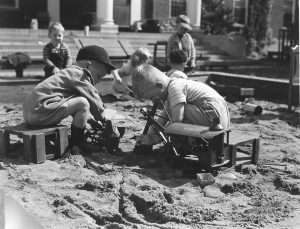
The Child Development Laboratory (CDL) is a care and education program for children under the age of five and a research location for those studying children’s behavior. Researchers of various subjects such as psychology and education can observe children as they interact and learn in their daily lives. In over 75 years of operation, the lab has been attended by more than 4,000 children, a place of research for 84,000 students, and the site of over 560 published research studies.
Founded at the University of Illinois in 1941, the CDL was placed in what was then the Women’s Building, now the English Building. It was first directed by Dr. Nellie L. Perkins, a leading sociologist with a background in chemistry who focused on child development. The laboratory was created at a time when the scientific method began being applied to child development, and was made so that researchers could have a subject pool of children for observation and experimentation in applying this method.

Eventually, however, Dr. Perkins found the location of the CDL in the Women’s Building to be inadequate. She wanted an environment of study that was made with children and observation in mind. After some back-and-forth with campus administration, Dr. Perkins was able to convince them of the necessity of this environment, and the CDL building was constructed in 1955. The building was constructed specifically for studying children’s development, with elements such as observation booths and data collection rooms to serve this purpose. It has remained the location of the CDL to this day.

According to Dr. Brent A. McBride, the current CDL Director, the most innovative quality of the lab at its founding was “the seamless integration of theory, research, and practice” in child development. This is to say that, in opposition to many other laboratory schools which work independently, a faculty member could work with teachers to observe children in the morning, and then share the findings of these observations with students at the university in the afternoon. Dr. McBride states that this smooth transition between theory, research, and practice is still to this day a model that laboratories like the CDL pursue.

Innovative practices of the laboratory have led to many well-renowned findings, such as the necessity of multiple exposures to new and healthful foods before children like them, which are disseminated and discussed across the world. The CDL also provides students on campus with research opportunities, with 77 student internship placements and 1,272 student class projects using research from the lab in 2016. The benefits of innovation at the lab are ongoing as research in child development continues to help children, teachers, and researchers.
– Child Development Laboratory Building. Located on Nevada Street.
– English Building. This is where the first Child Development Lab was located.
Children at tables in Child Development Lab. (1945). Nellie L. Perkins Papers, 1912-68. Record Series 8/11/26, Box 4. University of Illinois Archives.
Children Playing at First Child Development Lab (loft). (1945). Nellie L. Perkins Papers, 1912-68. Record Series 8/11/26, Box 4. University of Illinois Archives.
Children Playing in Child Development Lab (cars and blocks). (1945). Nellie L. Perkins Papers, 1912-68. Record Series 8/11/26, Box 4. University of Illinois Archives.
Children Playing outside First Child Development Lab (sandbox). (1945). Nellie L. Perkins Papers, 1912-68. Record Series 8/11/26, Box 4. University of Illinois Archives.
McBride, Brent. (30 November, 2018). Personal interview.
University of Illinois, Child Development Laboratory. (2017). Child Development Laboratory Annual Report: 2016-2017. Retrieved from https://cdl.illinois.edu/wp-content/uploads/2017/12/2016-2017-Annual-Report.pdf
University of Illinois, Child Development Laboratory (n.d.). Child Development Laboratory: 75 Years of Impact by the Numbers.
University of Illinois, Child Development Laboratory. (n.d.). History. Retrieved from https://cdl.illinois.edu/history/
University of Illinois, Human Development and Family Studies. (n.d.). From Bevier to Christopher to YOU: Our Historical Roots. Retrieved from https://hdfs.illinois.edu/about/history
